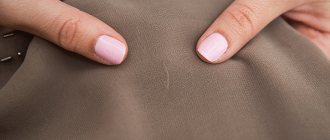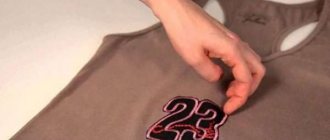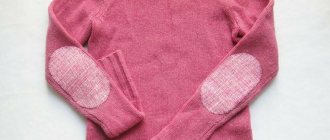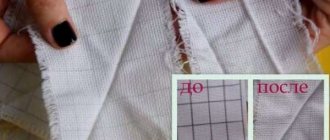True, there are options in which it is not worth wasting time on repairs:
- if the hole is too large, the patch will be visible, or the fabric will have to be sewn too tightly;
- if thin, delicate material (silk, organza, mesh) is damaged - in this case, traces of the repair of the item will be noticeable in any case, even if you contact the studio;
- if there is not one hole, but several small holes not far from each other;
- if the thing is worn out on its own, in this case it is worth following the rule “Better to buy new than to repair old,” because one repair may be followed by another after some time.
However, in all other cases, any item of clothing can be repaired - but it is important to know how to properly organize the process and strictly follow the procedure so that the item will please you for a long time.
Wedge with wedge
If your favorite sweater has been damaged by a moth, hide the hole by making an ironic appliqué in the shape of... a moth! Take a piece of felt as a basis: this will strengthen the affected area and at the same time hide it.
Felt is an indispensable assistant in hiding a wide variety of damage, especially when it comes to children's clothing. Well, doesn’t this red felt heart look cute, looking flirtatiously out of its pocket? Especially if you use contrasting threads for sewing (see main photo).
How to sew a patch by hand using an invisible seam
If it is not possible to mend a fiber break, then the only option to eliminate the defect is to apply a patch. To attach the patch, it is not necessary to use a sewing machine - just create an invisible seam and choose the fabric to match the main fabric.
Instructions for sewing a patch
Algorithm for how to sew a patch manually with an invisible seam:
- Place fabric on the wrong side of the hole and measure out the required amount and shape of fabric. You need to take 2 cm more from each edge of the hole.
- Straighten the piece of fabric and fasten it to the main fabric using a basting stitch or safety pins.
- You need to sew up moving clockwise along the edge of the hole. A blind seam is formed using unusual stitches. Bring the thread and needle to the front side. Thread the needle through the fabric again next to the first puncture. At the same time, form a loop from the thread, and guide the needle opposite the first two punctures and form a small stitch to secure the loop. Each seam is repeated in this pattern. When the last stitch is formed, you need to unravel the loops. This can be done by simply pulling the thread.
Blind seam
Important! In order for the seam to unravel, you do not need to secure the loop with a stitch in the last stitch.
You can simply form even small stitches from the front side of the patch. But controlling the position of the needle and the size of such stitches is much more difficult. The patches make it very easy to repair children's pants.
Bright shreds
An interesting option is to hide the hole from prying eyes by completely covering it with embroidery and adding a few more colored rectangles nearby. This imitation of patchwork will require not so much skill as patience:
- outline the desired area with a “forward needle” stitch;
- apply a base mesh (can be diagonal);
- by passing the needle alternately over and under the warp threads, create a woven fabric.
Is this an accident?
Yes. Since the definition of an incident includes the participation of a vehicle and the presence of damage (or injured/dead people), then in the vast majority of cases the situation when you snatched a gun at a gas station falls under this definition according to the traffic rules.
And there are 2 important subtleties here:
- if you have not registered the removal of the pistol as an accident, then this may result in deprivation of your license for leaving the scene of an accident - part 2 of article 12.26 of the Code of Administrative Offences,
- if you called the traffic police, the situation may turn out to be better than your expectations (more on this below).
The fact is that most drivers immediately pay for the damage for a broken hose, not realizing that their liability is insured.
Is there a penalty?
No. The Administrative Code in force for 2022 does not provide for an administrative fine for the very fact that you tore the gun away from the pump. There is a penalty for leaving the scene of an accident as a consequence, but there is no fine for the fact of pulling out the tap.
But there is civil liability to the gas station for causing material damage, if such damage occurred.
Blazing Chaos
Sometimes you need to hide not a hole, but, for example, a stubborn stain or even several stains nearby. Why not turn them into a scattering of beads, shimmering with all the colors of the rainbow?
Rare shot: Viktoria Isakova showed her grown-up daughter from Yuri Moroz (new photo)
“We are still friends”: Derevianko commented on the breakup with his wife
A student at the Vietnam Police Academy shared how she takes care of her facial skin.
Choose a mix of several shades of beads or find a bag with the so-called gasoline color. Add some beads or beads and cover the entire area of the stain, placing the beads close to each other.
Bolognese jacket repair
Bologna is a compacted artificial fabric made of polymer threads that are treated with a water-repellent and airtight composition. Bolognese jackets provide excellent protection from rain and damp fog; they are suitable for hiking and outdoor recreation.
Important! The inventor of this material lived in Italy in the city of Bologna, hence the name of the fabric and jacket.
Clothes made from Bologna are very popular and irreplaceable in the wet, cold season of the year; this is precisely the quality that is valuable in them. The downside is that the rubberized fabric is not tear-resistant enough, so jacket owners often look for an answer to the question of how to put a patch on a bologna jacket, because the material is not so easy to sew up. Common causes of damage to a Bolognese jacket:
- Burnt by a cigarette or other hot object;
- Cut (by a blade or sharp object);
- Hooks from a nail, branch, hook, etc.
You will need the following materials for work:
To repair a polyester jacket with your own hands, you will need:
- Glue “Super Moment” or KP-1;
- For degreasing, acetone or gasoline;
- A piece of fabric for a patch, matching the color;
- Polyethylene or non-woven fabric;
- Application;
- Iron;
- Gauze or soft natural fabric.
A Bologna jacket can be sealed in several ways using the above materials. Let's look at each method in more detail.
Method 1 - using a fabric patch
To seal the hole, select a piece of fabric and glue that is suitable in size, texture and color.
Proceed like this:
- Turn the jacket inside out and place it on a flat surface;
- Degrease the tear area from the reverse side with acetone or gasoline;
- Apply a thin layer of Super Moment or KP-1 glue to a piece of patch;
- Connect the edges of the hole exactly;
- Apply the patch;
- Place the area of the jacket to be repaired under a press for a few minutes;
- Turn the jacket inside out and inspect the result. If traces of tearing are visible, disguise them with appliqué or other suitable elements.
Important! You can stick thematic inscriptions or pictures on the sports jacket, at the tear site.
Method 2 - use polyethylene or non-woven fabric
How to seal a polyester jacket, prepare: a special tape of dry glue (non-woven fabric), a piece of fabric matching the color, an iron, gauze.
Important! Instead of non-woven fabric, you can use regular cellophane.
Detailed instructions:
- Turn the product inside out and place it on the table;
- Spread the lining to get to the cut;
- Cut a piece of polyethylene or non-woven fabric slightly smaller than the patch;
- Connect the edges of the gap;
- Apply polyethylene (non-woven fabric) from the inside out and carefully smooth it out;
- Place a fabric patch on top of the polyethylene;
- Iron the joint with an iron, gauze or soft cloth. This will allow the polyethylene to melt and firmly fix the patch;
- Turn the product inside out and evaluate the result.
Perhaps the defect will be slightly noticeable, but you know about it, and those around you are unlikely to carefully peer at your jacket.
Not to hide, but to stick out
Most often, certain areas of clothing are affected, such as around the back pockets of jeans. Make a bright patch in this place and highlight it with bright embroidery.
Another option for repairing clothes is to make a patch. Sew the fabric along the perimeter of the hole using a machine, and then add embroidered elements - stars, crosses, small flowers or anything else.
Found a violation? Report content
The jacket is torn - what to do?
The material from which outerwear is made is not always of ideal quality; it happens that an expensive jacket bursts at the seams from awkward movement. To avoid such situations, use these methods:
- Sew (darn) the gap;
- Seal;
- Mask with reflective tape or clothing sticker;
- Apply a fashionable patch;
- Glue stickers, embroidery, applique.
The choice of repair method largely depends on both the material of the item and the location of the hole. You can stick a sticker if the jacket is torn in a visible place, but sewing up a Bolognese jacket is not entirely aesthetically pleasing. Let's take a closer look at the methods of repairing outerwear depending on the type of damage, for example, how to seal a leather jacket at home and much more you will find below.
We update the down jacket ourselves
If you carefully repair the damaged area, not a trace will be visible.
If a torn hole appears, you can not only sew everything up or apply a patch. Various types of applications are popular now. You can use this. Thus, you can not only get rid of the hole, but also update your down jacket.
Before mending a tear, you should visit the appropriate store to select a decal or pattern. A similar method can be used if the sleeve or main part of the jacket is torn.
Iron-on adhesives and applications
Appliques and stickers can help out in many cases, but this method has a drawback. You can sew on a pattern or stick on a beautiful picture only where it is appropriate, namely:
- On the sleeves;
- On the chest;
- On the pockets.
In other cases, the stickers will look stupid, which means it’s best to consider another way to fix the holes. If embroidery was chosen, it should be done on a separate fabric, which will subsequently be sewn to the torn area of the jacket.
Braid or tape
You can disguise the hole next to the seam using tape. Many people are interested in the question of how to fix a hole in a jacket so that it is invisible and also beautiful. It's simple, you should use all your imagination. It doesn’t matter what length or color the braid is. Don't be afraid to experiment.
Another way to disguise a hole is with reflective tape.
The advantage of this method is that it will not only hide the defect, but will also make the jacket visible at night. You need to cut a piece of tape and carefully stick it over the gap.
Even very good clothes tend to tear in the most unexpected places. You accidentally ran into a nail, or your favorite four-legged creature decided to let out its claws - and here you are, a hole. I don't want to throw away my beautiful new jacket. And there is no need to rush to the garbage chute. In most cases, clothing can be repaired, and it can even be done without the damage being noticeable.
How to fix a hole in a jacket: video
Sashiko and boro in clothes
In the modern world, intricate boro embroidery is a style that has found its way into high fashion, but it was originally developed, as mentioned, by poor workers to preserve their expensive fabrics.
Boro and sashiko style clothing are related in history, but are not interchangeable. Thus, sashiko refers to a style of embroidery, while the word Boro means rags or torn cloth and refers to the fabrics used rather than how they are put together. Also, these techniques originated sometime during the Edo period (1615-1868), when white indigo thread was often used to repair and repurpose fabric.
Boro can best be defined as the conscious Japanese art of fabric repair, while sashiko is a form of sustainable embroidery to strengthen fabric.
Cotton in those days was a luxury available only to the nobility. The lower classes had homespun fibers, which were more difficult to turn into fabric and did not last long. By patching and stitching the fabric could be strengthened and its service life extended. During the Edo era, there were also laws prohibiting the lower classes from wearing bright colors, so fabrics were indigo blue and brown, using cheap and readily available natural dye.
The thread used to make boro is the same as that used for sashiko and this is primarily because when mending boro, old vintage fabrics are used. Tightly twisted yarn from a standard linear thread would tear apart the antique instead of holding the garment together. A valuable vintage sashiko item will often include some Boro patches as part of the clothing. Meanwhile, after the Meiji golden period, as living standards began to improve and money reached the lower classes, families began to throw away boro clothing as a visible sign of poverty. Now there is a change - the modern form of boro has become a movement encouraging us to rethink the way we consume clothing in the age of convenience. Today, boro has seen a resurgence in popularity, merging with the Japanese aesthetic of wabi-sabi, which means unfussy simplicity. Thus, on the global platform, Boro reproductions are produced by retail lines to decorate clothing, and at the lower level it is practiced as a craft. At this stage, 1,500 Boro antiques are on permanent display at the Amusement Museum in Asakusa, Tokyo, and the government has designated several of the best items as tangible cultural assets.
Sashiko clothing style: 6 questions and answers
The beauty of sashiko is in its simplicity. A humble running stitch can outline the most intricate design, and by using traditional Japanese geometry, we are constantly discovering new twists on this old and magical art form.
How is Japanese embroidery different from sashiko?
Sashiko is just one of the Japanese embroidery techniques. Japanese embroidery, or nihon shishu, has been practiced for centuries, even before sashiko became popular, and includes many more embroidery techniques. Initially, Japanese embroidery was used only to decorate religious rituals and works of art. Over time, as shishu developed a unique Japanese aesthetic, it began to be used for more artistic purposes.
In the early Heian period, Japanese embroidery was primarily used to decorate the clothing and costumes of court ladies. During these years, shishu was exclusive to the upper classes as they were the only ones who could afford such expensive clothing. However, during the Edo era, as cotton began to be spread throughout the country by maritime traders, lower-class workers began to popularize sashiko as a method of repairing worn-out clothing.
What is Japanese boro?
Japanese boro is a type of Japanese fabric that is sewn together. The term comes from the word "boroboro", which means something is torn or repaired. Today, Japanese boro embroidery is used as a modern, fashionable look to tie different garments together. Traditionally it was used to preserve heat by weaving hemp because cotton was a rarer commodity at the time. Hemp was more common, but cotton was a tropical plant and could not be grown in the colder areas of the Tohoku region. In this case, Boro became known as the clothing worn by peasants and farmers.
What is Sashiko used for?
Today, sashiko is primarily used for Japanese quilts and to create boro fashionable clothing. So, they use simple stitching to create a unique background with different geometric patterns. Also, modern sashiko adds a creative and decorative style to traditional repair and patchwork. Notably, the sashiko style of clothing and sashiko fabric designs come from nature, such as clouds, waves or flowers, and are considered more of an artistic expression than a practical use. Traditionally, sashiko in clothing was used to strengthen or repair worn or torn fabrics. As a result, after repair, the part will be stronger due to the strong sashiko thread.
One of the indispensable aspects of any developing craft is its potential, which sashiko is especially rich in. Thus, Sashiko is used in any kind of products such as clothing, bags, accessories such as sunglasses, jewelry and shoes, as well as home furnishings such as pillows, rugs, blankets, bedspreads and wall art.
What kind of fabric is used for sashiko?
For sashiko embroidery, blue fabric is used - indigo, this is the most commonly used fabric.
What is the difference between Sashiko thread and embroidery thread?
Sashiko thread is traditionally made from 100% brushed cotton and has a tight twist. Sashiko thread is also non-split, which means it cannot be separated into strands like other embroidery threads. You can also use cotton floss, but it does not have the same texture and bend as sashiko thread, so the final product will look a little different.
What are Sashiko needles?
Sashiko needles are sharp, thick, and more durable than traditional needles. They also come in different sizes. First of all, it is important to choose a needle of the appropriate thickness and length for your project. Therefore, for tight weaving, use needles that are shorter and smaller in size. So for looser fabrics, you can use longer needles to pick up more stitches at a time. You can try using embroidery needles or regular sewing needles as an alternative, but the right sashiko needle will make sewing more enjoyable. It is not necessary to use thimbles.
Important note!
- This article provides basic information, but each case is different.
- In 92% of all situations there are important nuances that can affect the outcome of the entire case.
- An experienced lawyer will study all the materials of the case and indicate in which direction to move.
Therefore, our website employs on-duty legal consultants who delve into each case and are aimed at solving it.
or consult toll-free: 8 (499) 938-43-58 (Moscow), (St. Petersburg), 8 (800) 350-14-83 (all of Russia).











